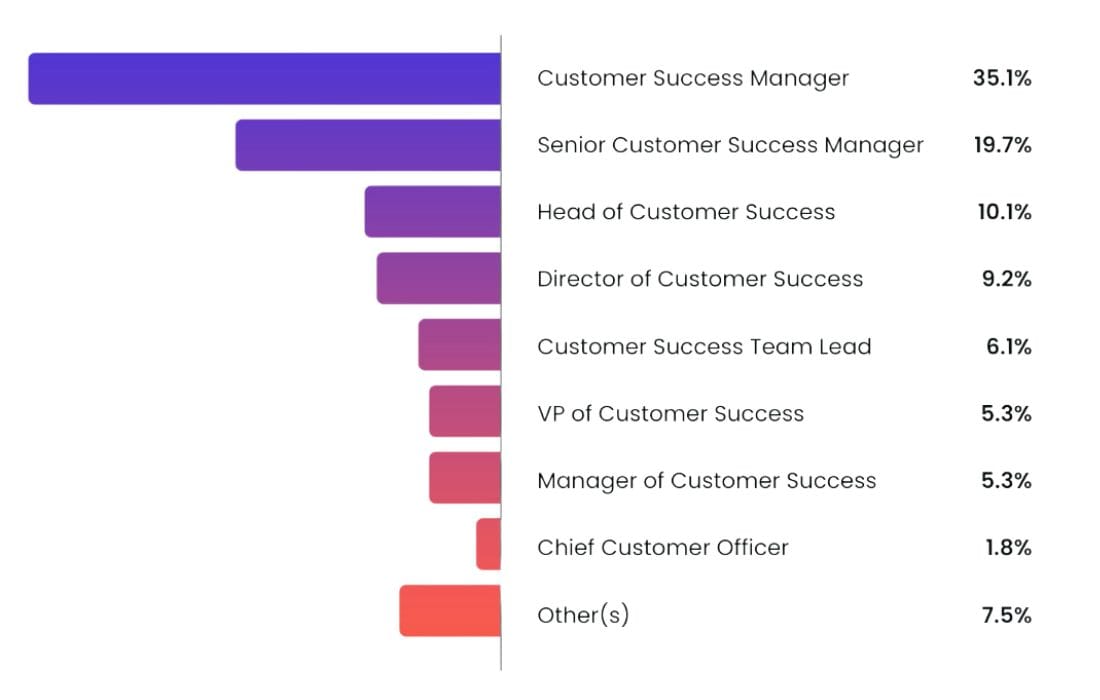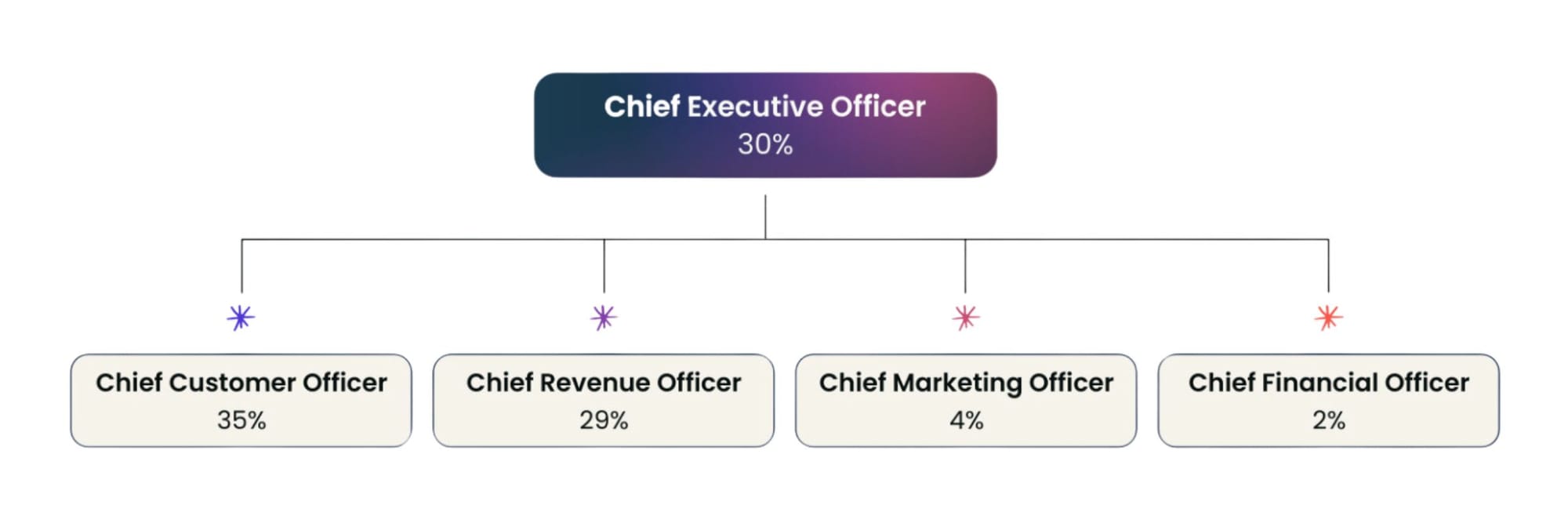The chief customer officer in an organization is "The Boss" of customer success – for the music fans out there, they're the Bruce Springsteen of customer-centricity, uniting teams, amplifying the customer's voice, and rocking the C-suite with customer-focused strategies.
A relatively new position in the C-suite, joining ranks with the CEO, COO, CMO and CRO, the CCO is truly doing the heavy lifting when it comes to promoting customer-centricity and positive, value-driven customer success.
To a CSM, who's living and breathing customer communication day-in-day-out, the value of customer success is obvious. But for someone in the C-suite fighting the good fight for a customer-centric culture and initiatives?
There's a unique opportunity to disseminate your values and make CS part of your company philosophy. The CCO ensures the customer is at the forefront of the executive board's mind, and is the leader spearheading the initiatives that drive customer satisfaction, engagement and renewals.
Read on to learn about:
- What a chief customer officer is
- What a chief customer officer does
- A chief customer officer job description
- Chief customer officer and organizational structure
- The growing influence of the chief customer ffficer
- Path to becoming a chief customer officer
- How to be an impactful chief customer officer
- Advocating customer success at C-suite level
- Why is customer success leadership so important for a company?
- Build a culture that values every customer interaction
- Want to network with CCOs?
What is a chief customer officer?
A chief customer officer is a key C-suite role that drives top-level strategy and initiatives, shaping customer success and influencing business growth.
It’s a role that’s becoming a recognizable pillar in the SaaS world, with a steadily rising number of companies adopting the new C-suite role. The Chief Customer Officer Council discovered that 22% of Fortune 100 companies and 10% of Fortune 500 companies have a CCO within their ranks – pretty exciting if you ask us.
The relevance of CCOs can be measured by one thing: how effectively they propel the mission of customer success across the company. Their role fuses customer and corporate strategy.
What does a chief customer officer do?
A chief customer officer is responsible for positioning their company’s wider plans alongside their team of customer success managers’ daily tasks and strategy, ensuring their KPIs are aligned with targeted metrics.
As an interdisciplinary role, the CCO needs to have an in-depth understanding of all elements of the customer-buyer journey. The reason for this? Their job is to understand how that customer has been brought through the sales process, why they’re a client of the company.
This knowledge is critical for the CCO’s overall strategy of driving customer loyalty, thus solidifying the customer base and generating revenue for the company.
Looking to implement a revenue-driving new initiative like monetizing customer success, but ordinarily need C-suite buy-in? That's where a CCO comes in.
Chief customer officer job description
The chief customer officer is the voice of the customer (VoC) to the C-suite, and therefore must champion a customer-centric culture across the entire organization. The key responsibilities of a CCO include:
Delivering exceptional customer outcomes
Driving a relentless focus on delivering exceptional customer outcomes, value, and experiences through cross-functional alignment and seamless customer journeys.
Developing and executing strategies and programs
The CCO is the strategic brains behind customer-led growth and therefore needs to develop strategies, initiatives and programs to maximize customer retention, loyalty, growth, and advocacy.
This will include leveraging data analytics, voice of the customer programs, and feedback loops to deeply understand customer needs.
Leading your customer-facing teams
The management buck stops with the CCO, the apex of customer-facing teams like customer success, customer support, professional services, training, education, and customer operations. It's the CCO's job to unite these teams and prevent siloes from emerging.
Cross-functional partnership
Another responsibility of the CCO is aligning between different departments. Partnering closely with sales, product, marketing, and other functions is integral to ensure tight coordination on customer acquisition, onboarding, adoption, expansion, and renewals.
Don't lose sight of the customer
Acting as the customer advocate, engaging directly with key accounts, infusing the voice of the customer into decision-making, and identifying growth opportunities through business development efforts.
Metrics and data
In order to prove ROI to the CEO and build a data-driven retention strategy, Chief Customer Officers must be able to manage core metrics such as NRR, GRR, churn, CSAT, customer health, advocacy/references, and cost of retention.
The ideal candidate will have 10+ years of leadership experience in customer-facing roles, exceptional strategic planning abilities, strong business acumen, and a proven track record of implementing a customer-first mindset to drive growth.
An advanced degree, expert emotional intelligence, communication skills, and deep customer service domain expertise are required.
Chief customer officer and organizational structure
Understanding the various structures of CS teams globally is a nuanced and enigmatic topic, something we’re super keen on investigating further. As CS grows as a function globally, so does the complexity of its teams.
This is a subject Jeff Justice Williams considers on our podcast, CS Build.
Jeff is the Senior Executive of Enterprise Customer Success at Box and notes the parallels between the globalization of customer success and the rise of remote working since the pandemic. He advises that now is the timJeff is to become an expert in the international market.
But how do location and company size affect CS teams? Is customer success structured differently based on the industry? Do companies with varying growth stages adopt the CS function? These are the questions we wanted to find out in our report, the State of Customer Success. And boy, did we.
In a survey conducted among over 200 customer success practitioners, we uncovered an interesting insight into the composition of roles within the field. Proportionally speaking, chief customer officer (CCOs) are significantly outnumbered by customer success managers (CSMs), with CCOs representing only 1.6% of our total respondents.

This statistic, while seemingly low, is not surprising when considering the organizational structure of global companies.
The plurality of CSMs, heads of customer success, and VPs in the field naturally outnumber the singular C-suite positions. This pyramid-like structure reinforces the strategic importance of CCOs at the apex of customer success operations.
It's crucial to contextualize this figure within the rapid evolution of customer success over the past decade. The field has made remarkable strides, transforming from a nascent concept to a critical business function.
As such, we anticipate that the number of CCOs will increase in correlation with the growing strategic importance of customer success in modern businesses.
While the current percentage of CCOs may seem low, it represents a significant opportunity for growth and elevation of customer success to the highest levels of organizational leadership.
As businesses continue to recognize the pivotal role of customer success in driving growth and retention, we expect to see more companies creating CCO positions, further cementing the strategic importance of customer success at the executive level.
Rebecca Fenlon is the Head of Customer Success at Cognassist, a leading SaaS platform that offers personalized learning through cognitive assessments. Rebecca is of the opinion that a CS team “should ideally report directly to the CEO or a CCO, and be parallel to sales and marketing – not sitting underneath them”.
Not only could this muddle team objectives, but it hinders the CEO from fully understanding the value of customer success. A CCO can provide an unadulterated, concise review of the work a customer success team does for a company.
The growing influence of the chief customer officer
In our State of Customer Success Leadership 2024 report, over one-third (35%) of customer success teams report directly to the chief customer officer, a natural alignment given the CCO's role in ensuring that customer success remains central to company strategy.

As customer retention and satisfaction become increasingly crucial for long-term business sustainability, the need for strong leadership in this area is more evident than ever.
However, the journey to becoming a CCO is not a straightforward path. Whether reporting to the CEO, the chief revenue officer (CRO), or a CCO, customer success teams are recognizing the strategic importance of leadership that advocates for customer needs at the highest levels.
For aspiring leaders in this field, the roadmap to the CCO position involves mastering a variety of skills and responsibilities.
To provide a clearer sense of what it takes to rise to this position, let’s explore some key steps and competencies that aspiring CCOs should focus on.
Path to becoming a chief customer officer
Aspiring to become a chief customer officer? It's a journey that blends hands-on experience, cross-functional leadership, and a relentless focus on putting customers first.
We've spoken to dozens of successful CCOs and they all say the same thing: it's hard graft, but the most rewarding job out there.
At our Chief Customer Officer Summit London in 2023, a panel of four distinguished CCOs spoke about their journey to the top customer success job, and conveniently provided a roadmap for aspiring CCOs out there:
- Alena Rosini, Chief Client Officer, EMEA, Media.Monks
- Jennifer Yorke, Chief Customer Officer, Ometria
- Jayne Liggett, Chief Customer Officer, ScreenCloud
- Elizabeth Blass, Chief Customer Officer, TrustArc
Their conversation covered crucial topics such as educating executive teams on the importance of CS, navigating career paths, balancing revenue and profit, and integrating support and services into the customer journey.
Here are the key steps and skills they've marked as essential to become a CCO:
Key steps on your CCO journey
1. Dive deep into customer experience:
Build a 360-degree view of your customers by immersing yourself in support, success, and sales roles. This firsthand experience is invaluable for truly understanding customer needs and pain points.
2. Master cross-functional collaboration:
A stellar CCO knows how to break down silos. You'll need to unite teams across sales, marketing, product, and beyond, ensuring everyone's aligned on customer-centric strategies.
3. Become the customer's champion:
As customer success gains prominence, position yourself as its most vocal advocate at the executive level. Your senior leadership team will go nuts if you can demonstrate how prioritizing customers directly impacts business growth and long-term success.
Essential skills to develop
1. Data-driven decision making:
Harness the power of customer metrics like net revenue retention (NRR). Use these numbers to prove that focusing on customers isn't just feel-good fluff – it's a strategic imperative that drives real business value.
2. Executive-level influence:
As CCO, you'll have a seat at the big table. Use your position to push for organization-wide accountability in delivering exceptional customer experiences. Your goal? Ensure every major decision considers its impact on customer satisfaction and long-term growth.
How to be an impactful chief customer officer
Are you looking to know what it takes to build a jaw-droppingly great team?
Over the past few years, Dan Farley, Global Head of Customer Success at Ocula Technologies, has developed the “HIPE” leadership framework that fosters a high-performance culture. It focuses on four elements:
- Hire: Attract A-players through meaningful questions and human connection.
- Inspire: Lead by example through vulnerability, decisiveness, and maximum empathy.
- Push: Stretch your team to their "flashpoint" — the place of maximum growth without breaking.
- Energize: Sustain the team’s high performance with purpose and mental health support.
Dan's done the hard work so you don't have to! His HIPE framework offers a robust approach for leaders like yourself to maximize your team's potential. However, let it be said, it can come with its share of challenges like emotional exhaustion and scalability. Setting a culture of high-performance reqi
Advocating customer success at C-suite level
We’ve previously honed in on the significance of having customer success represented at the C-suite level, having interviewed the legendary Michelle Wideman, Silverfort's own CCO. Customer success can only be taken as a serious change for good when its concerns are addressed to the big decision-makers, specifically the CEO.
In this interview, Michelle addresses a number of challenges CS faces internally. Cross-departmental collaboration is a huge topic when it comes to advocating customer-centricity. Michelle asks two all-important questions:
- Are other departments ensuring customer experience to the maximum in the sales process?
- Can your finance team streamline the payment process to avoid unnecessary friction and pain points for the customer?
Michelle reinforces the point that the CCO position enables executive influence, drives accountability, and offers solutions in their position. Being in the C-suite provides the perfect platform to disseminate the monumental benefits of a well-oiled customer success strategy across an entire company.
Why is customer success leadership so important for a company?
We asked some customer success leaders why they find the role so important for a company to have. Here’s what they had to say:
Jenelle Friday, VP of Customer Success at Forecastable:
"Customer success leadership plays a crucial role in a company's success by:
- Fostering, maintaining, and growing strong customer relationships
- Driving customer satisfaction and loyalty
- Improving customer retention
- Enhancing product adoption
- Gathering valuable customer insights
- Strengthening the company's brand reputation
"Effective customer success leaders ensure the customer's voice is heard at the highest level of leadership ensuring that customers get the most value from their investment."
Jess Galenski, Director of Customer Success at Apryse:
"Leadership in customer success fosters a company culture that prioritizes customer outcomes across the entire organization. This mindset leads to better alignment cross-departmentally, ensuring that everyone from sales to product development is focused on delivering value to customers."
Mark Higginson, Chief Customer Officer at ScreenSteps:
"Remember that old saying, 'All roads lead to Rome?’ Well, my friends, customer success is Rome. Think about it: new business flows into CS, product feedback is channeled through CS and targeted marketing strategies are shaped by customer collaboration and insights.
"Customer success is the crossroads of all activity, where everything converges. Having someone to help orchestrate these touchpoints is critical. If you’re not leveraging this role, you’re leaving opportunities on the table."
Raymond Otero, Director, Global Customer Experience (Strategic) at Microsoft:
"Customer success leadership is crucial for a company because it ensures that customers achieve their desired outcomes while using the company's products or services.
"CS leaders act as journey coaches, guiding customers through every stage of their interaction with the product, from pre-purchase to post-purchase. They’re present before and after the deal is closed, serving as catalysts and accelerators for customer success.
"These leaders play a pivotal role in driving optimal operational excellence by acting as the voice of the customer within the company. They gather valuable feedback and insights, which help in refining products, improving services, and enhancing overall customer experience.
"By ensuring that customers are satisfied and successful, CS leaders contribute to higher customer retention rates, increased loyalty, and ultimately, the long-term success of the company."
Build a culture that values every customer interaction
The role of a chief customer officer is pivotal in fostering a customer-centric culture within an organization. At its core, customer success is about ensuring that customers realize the value of your product or service, and achieve their desired outcomes.
While this concept seems straightforward, embedding it into every facet of the business requires strong leadership from the top. The CCO's responsibility is to cultivate a work culture that prioritizes customer satisfaction, empowering employees to deliver exceptional service in every interaction.
This leadership sets the tone for the entire organization, ensuring that customer-centric values permeate through every department, influencing decisions and actions at every level.
Building a customer-centric culture begins with a clear vision that places the customer at the forefront of every decision.
Have a clear vision
To achieve this, cross-functional collaboration, data-driven decision-making, and continuous improvement are essential. CCOs must align internal processes, provide ongoing training, and ensure that employees have the autonomy and resources to address customer needs effectively.
Measure success
Measuring success through key performance indicators, such as customer satisfaction and retention rates, allows organizations to refine their strategies and maintain a competitive edge.
Ultimately, when the entire company embraces customer-centricity, strong relationships, increased loyalty, and sustained growth naturally follow.
Want to network with CCOs?
Join an exclusive network of C-suite customer leaders worldwide for a unique opportunity to connect with peers, tackle shared challenges, and gain valuable industry insights to drive future growth.
Apply now to secure your free invitation and be part of this transformative experience.



 Follow us on LinkedIn
Follow us on LinkedIn











